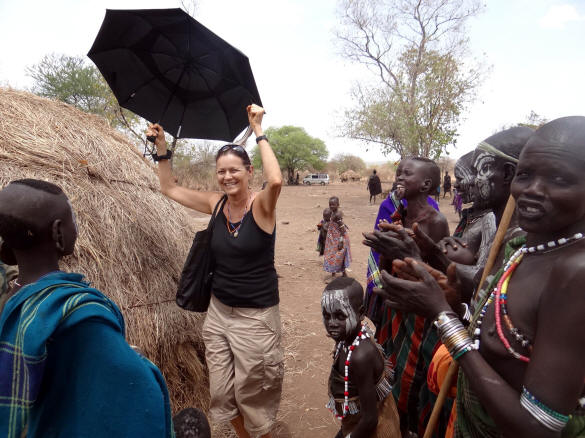Star Date: April 2015
Ethiopia II – Omo Valley
Hello Dear Family & Friends!
“Pi O. Fayao?”
(Hi How are you? Hamer tribe)
“Achalea. Merisha?”
(Hi How are you? Mursi tribe)

Happiness Attracts Happiness!
(The Secret)
Only 50 years ago the tribes of Omo Valley had no idea that Ethiopia existed, yet alone the continent of Africa, or the wider world. Tribal wars kept them focused on the threats at hand. From Arba Minch we passed by the Sili area which is rich in banana plantations and saw our first tree full of hanging, hand made, bee hives. Slowly t-shirts, shorts and paved roads gave way to potholes with potholes. Driving further and further south from ‘civilization’, only goats and herders punctuated the dry savannah. One herder was wearing his drinking gourd for a hat. Out here it is adapt or perish. Soon after, tribesmen walking through the bush would magically appear and disappear; on their way from nowhere on to nowhere. Further on, hours and kilometers later, feathers, beads, hats, spears, walking sticks, sitting/sleeping stools in tow, bare breasts, men in loin wraps; all announced we had entered Hamer and Bena territory. Our destination was the Dimeka Saturday Market but as is often the case in traveling, the journey is as fascinating as the destination. Six hours later and a hundred walking tribes people striding towards our common goal; we arrived at Dimenka.
Nothing had prepared us for the sight that awaited us in this remote village; Hamers, Benas and Karos mingled and mixed in a small area, going about their weekly buying, selling and trading. Casually we walked in the frenzy and observed the action, occasionally joining in to buy a small wooden stool/pillow, a colorfully decorated calabash gourd or the bracelet offered off someone’s arm. We bought small handicrafts from 6 different tribes people, giving everyone a smile. Bargain hard, then win, win.
Invited to attend a Hamer initiation ritual of bull jumping, prior to marriage, we accepted and were soon bumping down one of the worst side roads we had seen, off the bad main road to Erea. What a once in a lifetime experience. Lasting over 4 hours we watched as groups of feisty women dressed in beaded leather, with braided hair covered in ochre mud and animal fat (goscha), jumped and danced back and forth in search of the whipping men. Men were bare-chested with short wrap around cloths covering essentials. A little small raised bun, decorated in a specific way, indicated that the man had killed an enemy or dangerous animal within the last year. Better that then the old tradition of a decade ago or of the neighboring Turkanas we had visited in N. Kenya several years before. They would kill the man then cut off his penis and wear it dangling down on his forehead. Like the head hunters we visited in Northern Philippines they couldn’t understand the authorities charging them with murder when they had taken several heads 8 years earlier. “We were only taking heads!” Also it used to be an ambush from the bush and a whack with a stick to finish off the enemy. Now with all the AK-47’s traded from the Sudan civil war, more damage can be done quicker. Tribal warring and lack of a peaceful existence has hardened many local cultures. This tension is easing a bit and instead of acting like several unnamed countries globally and just taking what resources they want by force, the tribes people are getting a small income from travelers visiting their villages. Granted a large percentage, as with the aid from the United Nations or World Vision, etc. never reaches the individuals who need it most, but this is how their culture is evolving. Possibly a bit more peaceful existence now because of these changes. Not always looking over their shoulder for the next ambush, attack or raiding of their only livelihood of cattle and goats, maybe they can relax a bit. I do still remember an account of head hunters in the Philippines. Even when life had settled down to a dull roar and danger was eliminated the head taking continued. The only conclusion drawn was that it was an old cultural habit and when the men got bored they started planning their next raiding party. Boredom is an enemy in itself!
Cultural violence in the Omo Valley is still evident in the way the tribes men treat their women. They are whipped until drawing blood, producing a long scar that is considered by the men to show how tough the woman is. If she loves the man or is loyal she will allow herself to go through this ceremony. He will remember this and take care of her if need be. The women are circumcised, to remove the male element, on the day of their marriage and spends the next 2 months recuperating in a hut, before the marriage union. Reading accounts from women in the Omo Valley it seems that regular beatings are the norm. “If I don’t make my husband’s coffee right he will beat me. How else will I learn to make it how he likes it?” Hopefully they will progress to simple good communication and/or explaining how things are to be done. Sitting next to the women or dancing with them I could feel the emotion and pain. So far to go.
Local ‘hooch’ or barley moonshine was freely given to men, women, and even children until everyone became a little tipsy. We shared a shade thatched roof and sat on leaves and cow hides, side by side, with villagers from the whole area. An hour later the whipping men were spotted hiding in the bushes and came running out with willow type sticks. The woman would stand in front of him, taunting him until he whipped her once on the arm or back, causing a bloody strip which would then become part of her scarring decoration. Other decorative scarring is made on the face, arms, torso by cutting the design with a knife then rubbing in ash or charcoal; causing a mild infection, and producing a raised welt in various designs. A person can be traced to their village by the patterns used.
Not into violence we preferred to watch the facial painting after witnessing the ceremony. Joseph talked to the young men next to him, via a translator, and brought out the element of violence towards women. Several agreed that this ritual must change. I spent a couple of hours later with a young Hamer man in town who wanted to study to be a guide. We bought him an Aramac/English dictionary for school. We talked for hours, to practice his English, and what a fascinating discussion. His brother would be bull jumping, then circumcised this year, in preparation for marriage. Next year it would be his turn. He had grown up in his Father’s compound with 3 wives and 12 children. His Father had not been educated or seen the need for it. With education comes change. Knowing of the shortages of land and resources this intelligent young man concluded that he plans to only marry one wife. They will have 2-3 children. She will not be required to scar herself or go through the whipping ceremonies. He will not drink or beat her. We warmly encouraged him and shook his hand vigorously. Off he went to his village in his school dress of t-shirt and shorts. Tomorrow he would be bare- chested and in a small wrap, decorated with beads, rings in his ears, in the traditional dress of his Hamer village. Blending in. But inside this young man’s head were carefully thought out but hidden ideas, which he will be able to implement, as an example for change in his Hamer tribe.
Beauty. My thoughts drifted. Any little blemish in the western culture is hidden or fixed immediately. Like Dr Seuss’s story about the little creature who was born with a star on his chest. Everyone made fun of him. But eventually everyone wanted a star like his on their chest. Peer pressure and capitalism found half the townspeople with “stars upon thars”. Rivalry developed. Herd mentality is a strong factor in every group, in the west or here. We all want to be accepted and beautiful, whatever that means within our ‘group’.
In Omo Valley scarification is required to show the strength of the woman. Without it she may only fetch 5 goats rather than a large 20 goat payment when married. Large dangling lower lips or plates inserted, ears stretched to reach the shoulders, feathers or bones inserted through the nose or chin, tattoos, body painting or heavy neck decorations or rings put on at marriage and never allowed to be removed are all common. Cuts and scarification covering the whole body, hair braided and rubbed with red dirt and animal fat. One set of leather hide body coverings, rather than a closet full of colorful clothes. Others had hair shaved and decorated with beads rather than combing and washing daily with the latest expensive shampoo and conditioner. Modern western women are often disconnected from Nature, busily going about their glitzy lives surrounded by bling-bling and consumerism. A Hamer hut reveals very few possessions, nothing but essentials in their lives. Survival is the priority. These women of Omo Valley are of the Earth. They live with the Earth. To the Earth they shall return. But how will they ever survive without a Gucci purse or a new I-phone ???
The ceremony continued. Once whipped the women were offered more hooch to ease the pain, followed by some famous Ethiopian coffee or tea from the coffee skins, brewed in large pots over the fire. Soon we were following the loud women who were singing and stomping the red earth, leg bells rattling. Led to a widening in the forest the women danced in circles around the cattle. Bulls got all excited and started mating with cows. The young groom, stripped naked of his previous loose goatskin, was led through an arch and blessed with milk and herbs. No need for a drum roll, the cacophony had reached a climax as the young initiate jumped on the back of the first unhappy bull in the line, then jumped over all eight. The thought of being under the hooves of the irritated bulls at that point kept his footing sure. Jumping down the other side he repeated this difficult move 5 times and with the crowds approval he was officially ready to take a wife. Seemed a lot easier than 8 years of medical school with a proper house and job in our culture, to begin the search for a bride. The intended bride’s family must now come up with 6-8 cows, 10 goats, a bottle of honey and a large calabash of butter. Together they will build a small mud hut for two, minus the white picket fence. Sleeping on a floor mat they soon will have children between them, up to 8 or 10. If the cattle multiply and the husband becomes affluent he can take another wife or two and population explodes exponentially.
Overpopulation. The concept of too many children and consequently not enough resources, food, clothing, education hasn’t dawned on these lively folks. In fact it hasn’t dawned on many people of this crowded planet. It used to be most people lived near a water source, now with overpopulation, as even in the United States, sheer numbers have forced people out further into the deserts. As little trees are burned into charcoal for cooking to feed all the hungry mouths, the trees become forests in bags alongside the roads. Without trees no rain. Without rain no crops and so no food. The desert moves further south on the African continent in the path of destruction innocently caused by overpopulation. Call it what you like. The lack of education regarding overpopulation is destroying part of this already over burdened planet. With droughts and shortages of food, change is inevitable. We observed many African local Aid workers driving around in their expensive SUVs, staying at expensive hotels. They seem far removed from the job at hand as administrative costs eat up most of people’s donations. Make sure you donate to a cause that sees the help/food/clothing/education given directly to the villagers in need; not the ‘Fat Cats’ milking the system. Maybe they should consider teaching the locals to fish rather than throwing them a fish once in a while!
Off to even more southerly Omorate the next day. We were so near the troubled Kenya border we had to register our passports. We had traveled by truck up through Turkana territory but were not able to cross into Ethiopia a few years back. Now we looked at Lake Turkana from this side.
Omo Valley is remote and difficult to travel to. When you come to Omo Valley, you can take the twice weekly buses, requiring 10-14 days, walking to the villages 5 to 10km off the road. You can take a tour ranging from $1300 to $3000pp for a week. Or you can pay $120 to $150 a day for a driver and jeep. If you choose the “pay as you go option” you must pay entrance to each village, pay a local guide, and pay 5bir per person to take a photo. Fees get annoying and add up fast but just remember that you must pay the fees one way or another and you are saving a lot ala carte! The only money that goes directly to the tribes people, not into the pockets of the government or the guide associations, is the photo money. That makes it ok to pass out 3-5 bir notes to grateful posers.
We drove 2 hours from the ‘middle of nowhere’ to the ‘middle of nowhere’, got stuck twice, crossed the Omo River in a tippy hand hewn dugout canoe (with crocodiles lurking) and walked through the bush to Ferrij, a Dassanech village. Remember to look for and encourage the lighter side of the villagers. We made friends with the women and danced up a storm. What Fun! The canoe had a narrow top so no chunky people allowed. It wasn’t that stable but the crocodiles were far away! The Dassanech people live in simple stick huts with large bundles of Sorghum stored on the roof. They live almost totally on Sorghum and mais or corn, grown when the flooding river recedes; following the 2 month wet season. During April and May many places in the valley are impassable, as the ground becomes like black sponge and the rivers flood. The women grind the sorghum on stones and cook it as porridge over the fire in their huts. Possibly a cup of coffee or more common coffee husk tea to chase it down, an instant replay for lunch and dinner. Maybe a little goat meat gets thrown in for special occasions.
Our trip to the Abore people was cancelled because the road was impassable next to a crumbling bridge. ‘The road is broken’ are not the words you ever want to hear. Instead we took the bumpy, sandy almost impassible road to the Karo people. Their Korcho village takes hours to reach but the location, high atop the bluff overlooking the Omo River is worth the trip alone. Villages near water have an extra advantage and obviously thrive better than those who have to haul water for miles. The fun thing about the Karo tribes people is that they discovered they could make paint from clay in the riverbank. Daily they paint their bodies in wild designs which is a treat to behold. And points for ingenuity as yellow beer caps and other refuse items were made into creative additions to their outfits. If I had had more time I would have tried a design or two. Get naked and get painted!
We had been watching the skies for rain. Thinking the rains, which allow the people of Omo to survive, would only be a bother, we were shocked to see that about 1 km from Jinka, we had to literally drive through the river. Once that water rose with the rain there would be no crossing. It rained one night but not enough to take out any of the roads. The major rains, unlike in the north, are for April and May. Enter climate change. Weather patterns for centuries can no longer be counted on. We had been wise to head directly south and our trip went smoothly or bumpy as the case may be. When the skies open the deluge erodes the land and floods the rivers and intermittent stream beds. The annual farming of sorghum and maiz in the dark, rich earth along the floodplain provides sustenance for these hardy people for the remainder of the year, in this otherwise dry barren savannah.
Centuries before the slave traders from Sudan raided tribes across the border. With unparalleled cruelty men, women, and children disappeared and were sold into horrendous lives as slaves. Story has it that the Mursi tribes decided to disfigure their women so they were repulsive to look at and thus not taken by the slave traders, or to discourage adulterers. Whatever the truth this practice of cutting the bottom lips and ears of young women, stretching them gradually, then putting a clay plate in the fold remains to this day. When the plates are removed the lower lip flaps in the breeze, and the poor woman is disfigured for life. It is a cultural practice full of pain and misery for the women, not to mention their female circumcision and regular beatings from husbands. We were told that having the plate is now optional but peer pressure from family especially, demands that it get done. It all comes down to the bigger the plate, the tougher the woman, the more cattle her family is paid when she is married. A distended lip loop that can be pulled over the woman’s head can fetch as many as 50 head of cattle. We did see several young women with babies who had not been mutilated. Changes do happen, even if slowly.
The Mursi young men have a tough road to matrimony, as the scars on Diamond’s nose and face attested to. Painted in white they go at each other with 2 meter sticks. It used to be a fight to the finish but now that seldom happens. The victor is carried off into the bushes by the villages eligible females and it is decided on the spot who gets to marry him. At that point he is like the old knock, knock joke. What is black and white and red all over? (a Mursi man after a stick fight or a newspaper, depending on the situation). This is not a land for the faint of heart.
Current fads in Omo Valley: hats, anything striped, second hand bras of any color or size; accents to their outfits such as beads, safety pins, metal watch bands, beer caps, feathers, shells, bits of colorful plastic, bracelets made of copper/brass wire or lead melted from bullets. I wish I had brought along some small, colorful carabineers to hook on to their ‘look’. I still find myself seeing a brass ring or bit of metal and thinking, “hey, that would make a great addition to a Hamer or Karo ‘look’.
The body painting, scar designs, lip plates, heavy necklaces, elongated ears with heavy earrings, feathers all decorate these proud people. Beauty? Who are we to judge? We noticed that the babies rather than being sparkly and alert were all dozy and dusty, with flies bothering their eyes. Even when the festivities and dancing and general happiness set in, the babies simply looked dull. All of a sudden we noticed that the babies were all wearing 5-6 bracelets around their tiny arms made of lead from bullets. These Mursi babies could possibly have lead poisoning. We walked over to the chief and elders and Joseph and our scout explained to them about the dangers of lead. He thanked us and we hope they will act on this potentially dangerous problem.
Don’t look now but there is a man with an Ak-47 sitting behind me in the jeep. Aggressive. The Mursi tribes in general are finally becoming less violent. Fifteen years ago they supposedly shot anyone who came near them wearing clothes. Still hard line at times, it is required that you take along a ranger with an AK-47 to protect you from wild animals or upset Mursis. We had no threats but our friends who drove their little jeep, without a ranger and gun, were surrounded by the tribe and not allowed to leave until they paid their way out. Very superstitious these animists live close to Nature and the tribe we visited walked 20 km to get muddy river water for their village. We saw several drinking river water that looked like chocolate milk. Life is hard. Living proof of adapt or perish. They are nomadic. Their ‘former’ territory, now Mago National Park, is expansive but the only animals we saw were some birds and a group of baboons. Further into the park there are elephants, lions, giraffes, etc but all animals have been driven further into the remote corners by tribes people and poachers. We got to meet a cocky but interesting Mursi man in Arba Minch, studying to be a teacher! Wow, talk about a fish out of water. While we walked along, ‘Diamond’ puffed up declaring he would go back and be a chief in his village in 5 years. We talked to him about how he as chief could make changes to stop the violence towards women. He told us how 15 years earlier a westerner, unknowingly brought a mirror into his village. Seeing their image in the mirror they were literally frightened to death; twelve dead in one afternoon. Interesting story. Whatever the reality we must be careful what our effects are on primitive tribes, simple actions can be devastating.
We had so much fun hanging with all the different villagers we visited in the Omo Valley. We soon developed a rapport with them by acting silly, dancing, singing or just radiating our genuine love for different peoples and their cultures. While others complained of the antagonistic behavior of the Mursi I would tell them of the ever present possibility to tap into their lighter side. I got them dancing and singing and laughing. We are all humans, we all have the same emotions and feelings. Their life is tough and so maybe they act rougher than other tribes. We intimidate them by showing up on their turf. Being proud people they make sure they maintain the upper hand of the situation; our village, our terms. They can also sense fear and probably push things more if they think they can get away with it. Like naughty kids. When I started making percussion noises and dancing the women clapped, a man stuck a feather from his head into my hair and soon there was a dance party. Laughing and singing, in turn about fair play, I demanded, as they do, and got 5 bir from the crowd. We laughed and laughed. We like to blow up a balloon and play circle games with the village children. When the raucous begins, parents gravitate towards the laughing and soon the whole village is welcoming us. Our new friends from Australia, Mac and Collin, blow up a soccer ball, start up a game, and leave the ball, worth its weight in gold, behind to an appreciative group of kids. Great idea but after 12 years of travel, balloons are easier to carry in our small bags. Stickers are also a winner. Travelers help shape experiences around us with our attitudes, openness, friendliness. Conversely if we are feeling over whelmed or upset or grouchy this rubs off. It is a big responsibility to be a good will ambassador all the time. At home or abroad, what vibes do we give out to those around us? Often ‘what goes around comes around’. Small, random acts of kindness DO have a powerful impact on our planet. Give it a try today!
And so it goes…………………………………..Next from the unknown to the unknown in remote S.E. Ethiopia. Let’s remember to look in the mirror and ask, “Am I happy?” If not, what changes do I need to make? Until that happens I decide right now to attract happiness into my life. How many smiles are we able to share with those around us?”
(You must be happy now to bring happiness into your life through the law of attraction. It’s a simple formula. Happiness attracts happiness. Yet people use so many excuses as to why they can’t be happy. They use excuses of debt, excuses of health, excuses of relationships, and excuses of all sorts of things as to why they can’t use this simple formula. No matter what the excuse, unless you begin to feel happy despite it, you cannot attract happiness.”) (The Secret)
Take care and Keep in Touch!
Love, Light & Laughter,
“xoxoox Nancy & Joseph
Travel notes:
1 US Dollar equals 20.37 Ethiopian Bir
Omo:
Omo trip notes:
Suggest 3-4 day trip.
Until 50 years ago the tribes people of Omo Valley didn’t even know Ethiopia existed. Wow is all I can say! We had such an amazing time hanging in the villages.
By chance ran into Eprhem. We can highly recommend Ephrem, in Arba Minsch. Helpful, Honest, Reliable, Good prices. He will design a trip for you from full tour to just driver, to bus up to see the Dorzes. We recommend a 3-4 day trip with Dimenka and Turmi Market, The Hamers and Bull jumping, the Karo (who paint themselves, and the Mursi with the lip plates. Prices $120-$150/day with driver. This is per vehicle so you can split the cost with others. Could be helpful to figure out admission fees to villages ahead of time – pay it to Ephrem- and then relax. (Can’t go April and May due to rain we understand)
Contact him at southernethiopiatours@gmail.com phone #+251-913-860-007
Don’t pay to go into market or get a guide. It is a place of business. Yes pay entrance to village and for a local guide who can talk the language and explain. Pay 3 bir for photo of kids and 5 bir for adults EACH. This is the only money that goes directly to the villagers. Just the way it is. We walked in – took photos while they were still all dolled up – then put the camera down and just enjoyed the villagers. Later they would bargain for photo prices when they knew it was their only option.
Mandatory fees: You must keep this in perspective. These fees are paid no matter what and are supposed to go directly to the tribes, although we doubt this happens. Organized tours cost $1500 to $3000 and the fees are included. Could be helpful to figure out admission fees to villages ahead of time – pay it to Ephrem- and then relax.
By hiring a driver and jeep you are still saving a lot of money. You can also go by bus to Jinka and Turmi on Tues and Saturdays but you must have a lot of time to do this. Still you must pay these fees. After all we are visiting their home and it is not that much. Just go prepared – know your prices. Once I showed the Karo village the expected fee of 550bir on our paper- We said that’s all we are paying. They agreed instead of the requested price of 900 bir. This whole entrance fee/guide association thing has gotten out of hand. Know your prices!
Must see markets: Saturday Dimeka Monday – Turmi Weekends seem to have more Bull jumping but this cannot be planned ahead. Just get your driver to ask around in Dimeka. Ask and keep asking. It will happen.
Ideas for a 4 day schedule to maximize time in Omo Valley
Saturday – Arba Minch to Dimeka by noon. Market -possible nearby bull jumping
Drive to Turmi- overnight
Sunday Karo tribe – possible bull jumping Or early morning to Omorate then Karo
Monday afternoon Turmi market with Hamers – possible bull jumping Or early morning to Omorate then back for afternoon market Drive to Jinka
Tues See Mursi then drive back to Arba Minch
Longer time in Omo you can add Konso villagers on the way back. Thursday Key Afar market worth a stop. Sit down and figure when the markets occur – they are the highlight as it allows you to wander around and observe the villagers in action. Omorate for day 4 At $120 a day set your priorities
Hamer :
We paid 400bir each for bull jumping- everything included – all the photos you want. You just blend into the crowd and enjoy an authentic experience with the Hamer tribe. Don’t miss this.
If you visit a village there is the usual entrance fee/guide fee/photo fee
Dassanech/Omorate:
800 bir total for 2 -boat, village entrance and guide
Karo/Painted tribe/high above Omo River – 550 bir total entrance and guide
Mursi/tribes with lip plates/drive across river from Jinka
400 for local guide and 200 bir each for village entrance
200 bir each Mago National Park entrance
115 bir for the scout with the gun
Dorze tribe – above Arba Minch
200 for guide 150 for village entrance 20 bir each on public bus for the 37 km up to the 2500 meter villages
Last bus back down about 6pm so start by 9am and ask to be dropped off at the village. Better yet contact Ephrem to arrange Asemamaw to show you his village for 200 bir (you pay his bus fare also and maybe buy some honey wine) asemamawasefa@yahoo.com, Asemamaw is a great guy and he loves to show you his village.
Arba Minch:
Must have lunch or dinner at the Paradise Hotel. Spectacular view.
30bir tuk tuk from town
Stay at the Tourist Hotel (500 bir)- a little quieter and a pleasant courtyard. Close to town – other nicer hotels on the outskirts but you must catch a tuk tuk.
Also you can visit the crocodile farm and take a boat trip across the lake – but you need to find others to share with you and it is a full day excursion.
Jinka:
Goh Hotel: quite clean, modern, ensuite. After Turmi it was the Ritz. Good food with copious portions. $14 night
Pass Goh -Do not collect $200.
The museum or S Omo Research Center was well worth the drive up the hill. They document stories of tribes people and help the cultures. Many dot paintings like Australian Aborigines and stringed instruments called kechaitas are on display.
Turmi:
Tourist Hotel, very basic with a shower and outhouse. The best feature is wind blows through the screened windows to cool you a bit when the electricity goes out – which is every night. You can charge your phones in the little common area.
The Green hotel next door ran out of water and out of our business as we moved next door. Both serve good injera fasting fir fir or pasta for 40 bir. Rooms at both places are overpriced for what you get at 350bir.
We went for a meal at the Buska Lodge. More upscale, good food, but it costs $40 up. Electricity only after 6pm.

Mursi women with clay lip plates.
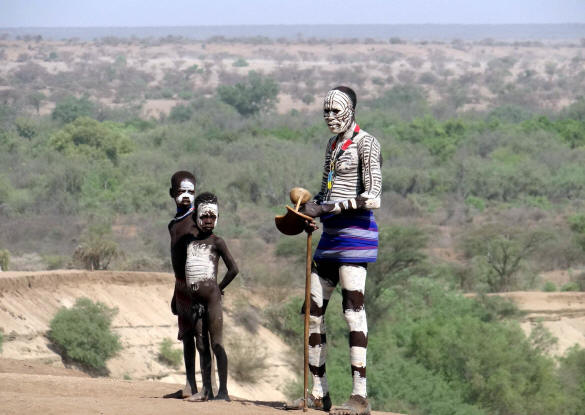
Karo people paint themselves with chalk from the banks
of the Omo River.
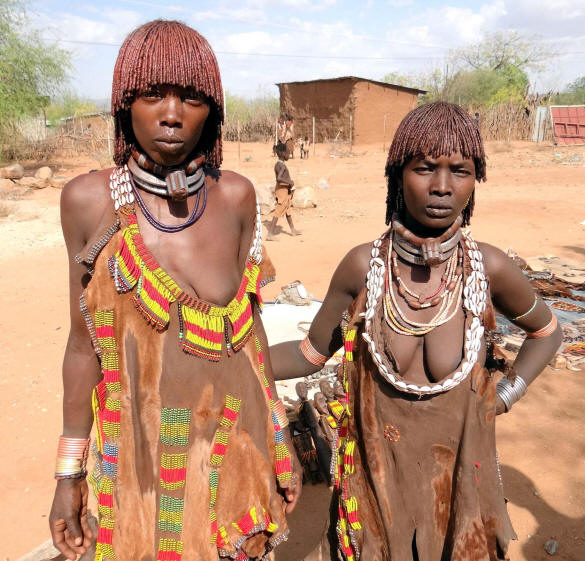
Hamer women.

Young Dassanech women.

‘Caught in the act’ – dancing with the Dassanech women.

Cooking coffee skin tea and sorghum in a Dassanech hut.

Everyone likes to dance!! Having fun with the villagers.

Vultures hanging out waiting for something to drop dead.
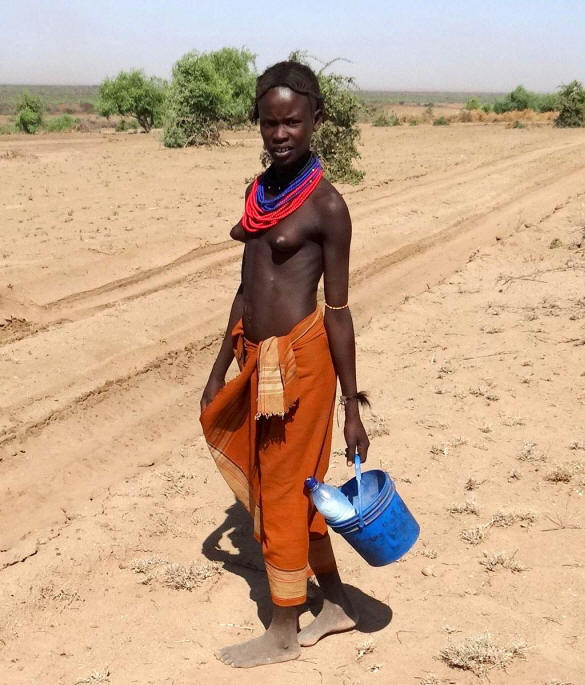
We got stuck in the deep sand on the way to Omorate. This girl and
her sister appeared out of nowhere.

A new friend at Dimeka Market.

Hamers, Benas and Karos mingled at the Dimeka Saturday Market.

A proud Hamer woman.

Socializing while doing their weekly buying, selling and trading.
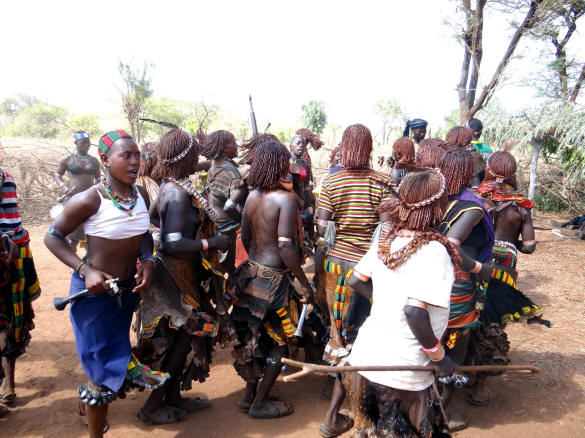
Hamer Bull Jumping Ceremony. Lasting over 4 hours, we watched as
groups of feisty women dressed in beaded leather, with braided
hair covered in ochre mud and animal fat (goscha), jumped and
danced back and forth in search of the whipping men.

The young studs of the Hamer village, checking out the girls.
I called the very cocky guy with the hat, ‘Sergeant Pepper’.
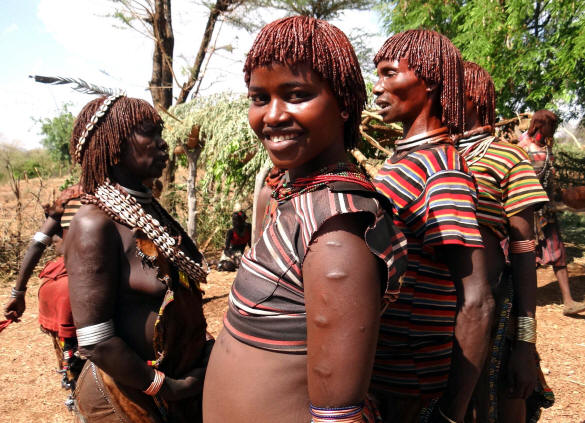
Beautiful, genuine smile. Notice the decorative scars on her arm.

Painting faces with clay, similar designs to the Australian
Aborigines, 8,000 miles away.

Villagers from the area gathered for the big event; eating, drinking and
socializing all afternoon and evening.

Mommy?!

We shared a shade thatched roof made for the event; and sat on
leaves and cow hides, side by side with villagers.

After an hour the whipping men suddenly appeared from the bushes.

The woman would stand in front of him, taunting him until he whipped
her once on the arm or back with a willow stick, causing a bloody
strip which would then become part of her scarring decoration.

Dancing during the build up frenzy leading to the Bull Jumping
Ceremony. We had so much fun hanging with all the different
villagers we visited in the Omo Valley. We soon developed a
rapport with them by acting silly, dancing, singing or just radiating
our genuine love for different peoples and their cultures.
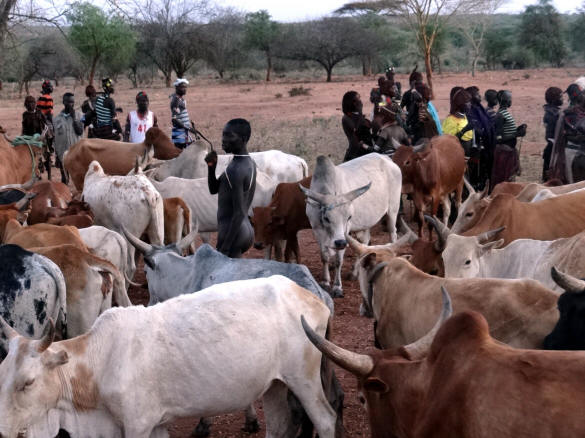
Gathering the bulls.

The young initiate jumped on the back of the first unhappy bull in the
line, then jumped over all eight. The thought of being under the
hooves of irritated bulls at that point kept his footing sure.









Baboons from the savannah. Man and beast must be
rugged to survive out here. When some people complained
of the antagonistic behavior of the Mursi I would tell them
of the ever present possibility to tap into their lighter side.
I got them dancing and singing and laughing.
We are all humans, we all have the same emotions and feelings.





